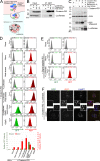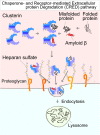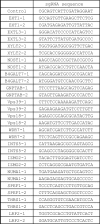Heparan sulfate is a clearance receptor for aberrant extracellular proteins
- PMID: 32211892
- PMCID: PMC7054991
- DOI: 10.1083/jcb.201911126
Heparan sulfate is a clearance receptor for aberrant extracellular proteins
Abstract
The accumulation of aberrant proteins leads to various neurodegenerative disorders. Mammalian cells contain several intracellular protein degradation systems, including autophagy and proteasomal systems, that selectively remove aberrant intracellular proteins. Although mammals contain not only intracellular but also extracellular proteins, the mechanism underlying the quality control of aberrant extracellular proteins is poorly understood. Here, using a novel quantitative fluorescence assay and genome-wide CRISPR screening, we identified the receptor-mediated degradation pathway by which misfolded extracellular proteins are selectively captured by the extracellular chaperone Clusterin and undergo endocytosis via the cell surface heparan sulfate (HS) receptor. Biochemical analyses revealed that positively charged residues on Clusterin electrostatically interact with negatively charged HS. Furthermore, the Clusterin-HS pathway facilitates the degradation of amyloid β peptide and diverse leaked cytosolic proteins in extracellular space. Our results identify a novel protein quality control system for preserving extracellular proteostasis and highlight its role in preventing diseases associated with aberrant extracellular proteins.
© 2020 Itakura et al.
Figures












Comment in
-
Heparan sulfate and clusterin: Cleaning squad for extracellular protein degradation.J Cell Biol. 2020 Mar 2;219(3):e202001159. doi: 10.1083/jcb.202001159. J Cell Biol. 2020. PMID: 32211896 Free PMC article.
Similar articles
-
Heparan sulfate and clusterin: Cleaning squad for extracellular protein degradation.J Cell Biol. 2020 Mar 2;219(3):e202001159. doi: 10.1083/jcb.202001159. J Cell Biol. 2020. PMID: 32211896 Free PMC article.
-
Heparan Sulfate-Based Neoproteoglycan for Targeted Lysosomal Degradation of Amyloid-β.J Med Chem. 2025 Jun 12;68(11):11979-11989. doi: 10.1021/acs.jmedchem.5c00845. Epub 2025 Jun 3. J Med Chem. 2025. PMID: 40462476
-
Alpha 2-macroglobulin acts as a clearance factor in the lysosomal degradation of extracellular misfolded proteins.Sci Rep. 2023 Mar 28;13(1):4680. doi: 10.1038/s41598-023-31104-x. Sci Rep. 2023. PMID: 36977730 Free PMC article.
-
The Dual Roles of Clusterin in Extracellular and Intracellular Proteostasis.Trends Biochem Sci. 2021 Aug;46(8):652-660. doi: 10.1016/j.tibs.2021.01.005. Epub 2021 Feb 9. Trends Biochem Sci. 2021. PMID: 33573881 Review.
-
Clusterin, other extracellular chaperones, and eye disease.Prog Retin Eye Res. 2022 Jul;89:101032. doi: 10.1016/j.preteyeres.2021.101032. Epub 2021 Dec 10. Prog Retin Eye Res. 2022. PMID: 34896599 Free PMC article. Review.
Cited by
-
Clusterin is a Potential Therapeutic Target in Alzheimer's Disease.Mol Neurobiol. 2024 Jul;61(7):3836-3850. doi: 10.1007/s12035-023-03801-1. Epub 2023 Nov 29. Mol Neurobiol. 2024. PMID: 38017342 Review.
-
Structural analyses define the molecular basis of clusterin chaperone function.Nat Struct Mol Biol. 2025 Aug 8. doi: 10.1038/s41594-025-01631-4. Online ahead of print. Nat Struct Mol Biol. 2025. PMID: 40781479
-
Polyphosphate in Antiviral Protection: A Polyanionic Inorganic Polymer in the Fight Against Coronavirus SARS-CoV-2 Infection.Prog Mol Subcell Biol. 2022;61:145-189. doi: 10.1007/978-3-031-01237-2_7. Prog Mol Subcell Biol. 2022. PMID: 35697940
-
Novel ACE2 protein interactions relevant to COVID-19 predicted by evolutionary rate correlations.PeerJ. 2021 Sep 15;9:e12159. doi: 10.7717/peerj.12159. eCollection 2021. PeerJ. 2021. PMID: 34616619 Free PMC article.
-
Caged Dexamethasone/Quercetin Nanoparticles, Formed of the Morphogenetic Active Inorganic Polyphosphate, are Strong Inducers of MUC5AC.Mar Drugs. 2021 Jan 27;19(2):64. doi: 10.3390/md19020064. Mar Drugs. 2021. PMID: 33513822 Free PMC article.
References
-
- Bell R.D., Sagare A.P., Friedman A.E., Bedi G.S., Holtzman D.M., Deane R., and Zlokovic B.V.. 2007. Transport pathways for clearance of human Alzheimer’s amyloid beta-peptide and apolipoproteins E and J in the mouse central nervous system. J. Cereb. Blood Flow Metab. 27:909–918. 10.1038/sj.jcbfm.9600419 - DOI - PMC - PubMed
-
- Bettens K., Brouwers N., Engelborghs S., Lambert J.C., Rogaeva E., Vandenberghe R., Le Bastard N., Pasquier F., Vermeulen S., Van Dongen J., et al. . 2012. Both common variations and rare non-synonymous substitutions and small insertion/deletions in CLU are associated with increased Alzheimer risk. Mol. Neurodegener. 7:3 10.1186/1750-1326-7-3 - DOI - PMC - PubMed
-
- Boland B., Yu W.H., Corti O., Mollereau B., Henriques A., Bezard E., Pastores G.M., Rubinsztein D.C., Nixon R.A., Duchen M.R., et al. . 2018. Promoting the clearance of neurotoxic proteins in neurodegenerative disorders of ageing. Nat. Rev. Drug Discov. 17:660–688. 10.1038/nrd.2018.109 - DOI - PMC - PubMed
Publication types
MeSH terms
Substances
LinkOut - more resources
Full Text Sources
Other Literature Sources
Research Materials
Miscellaneous

